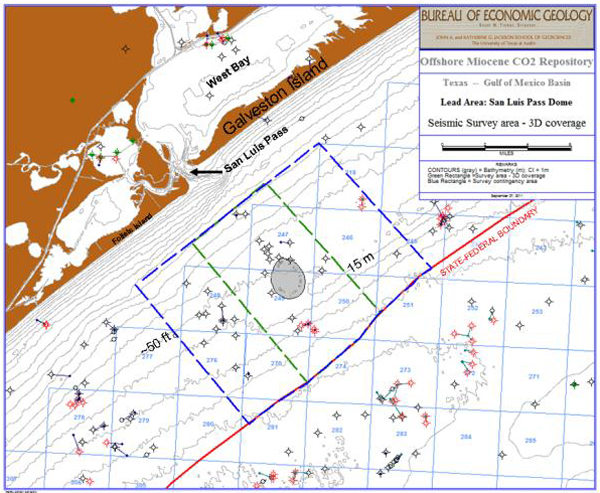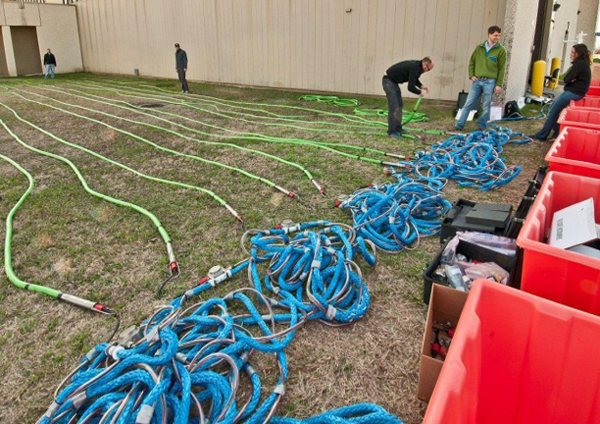Texas Offshore Miocene Project, Task 9
Site Selection
Task 9 involves identification of highly prospective targets for CCS in the inner-shelf of the upper Texas coast. We have identified an area of detailed focus offshore southern Galveston Island, where salt evacuation mini-basins and growth faulting interact to set up intervals of thick net sand and broad structural closure. During the first half of 2012, GCCC analyzed existing continuous 3D seismic data in the State waters offshore Matagorda, Brazoria, Galveston, and Chambers counties. We regionally mapped multiple seismic horizons in a depth volume and correlated these with paleontological 'picks' to constrain the approximate stratigraphic age. Significant effort was put into generating detailed fault plane interpretations. Some of this work is documented in Nicholson (2012), and it is available on the GCCC bookshelf.

On July 17, 2012 at 1:30 AM, the Research Vessel “Iron Cat” left the port of Amelia, LA destined for an area offshore from San Luis Pass (SLP), TX (southern tip of Galveston Island) for a two-week, 3D-seismic acquisition cruise. The area, associated with a salt dome a few miles offshore from San Luis Pass, was selected as a potential sequestration site. The aims of the data collection were to better understand the overburden fluid history, using a petroleum systems approach to prove up regional top and fault seal.
The P-Cable, shown below during an on-land inspection, is a new seismic system that relatively-inexpensively collects high-resolution 3D datasets of the shallowest 0 to ~1000 milliseconds of two-way travel time. One objective of the study was to collect such data sets in order to focus on higher resolution definitions of reservoirs, faults and fluid systems possibly including indications of fluid migration. Specific to the cruise, well data from the San Luis Pass area (including the near surface portion of the SLP salt dome) indicate that some wells that were drilled as hydrocarbon prospects were unsuccessful in finding commercial quantities of oil or gas. It is important to understand the petroleum system in the area in order to determine why hydrocarbons did not accumulate and what implications that might have for carbon geo-sequestration in this area and others. The high resolution P-Cable data adds important information to understanding of the geology of the San Luis Pass Salt Dome area. The survey acquisition cruise continued through July 31 and resulted in data acquisition over approximately 60% of the proposed acquisition area.

Chief scientist Tip Meckel (in yellow hard hat below) and crew members watch as one of the paravanes is deployed for the first time. The paravanes spread out the P-Cable array into its deployed configuration and are, therefore, critical for the correct functioning of the system, as described in Task 8.

Reference Cited
Nicholson, A.J., 2012, Empirical Analysis of Fault Seal Capacity for CO2 Sequestration, Lower Miocene, Texas Gulf Coast: Geoscience, The University of Texas at Austin, p. 88.
<< Back to Texas Offshore Miocene Project main page || << view previous Task || view next Task >>



